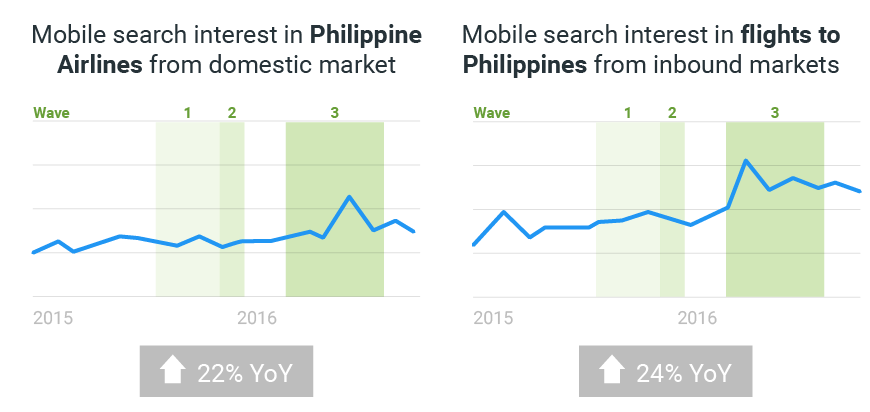Philippine Airlines aims to be a five-star airline by 2020.
In 2015, the brand rolled out a three-wave test with Search ads to gauge consumer interest for PAL tickets online.
As of Nov 2017, PAL has driven 36X higher average return on investment (ROI) from all booked online ticket sales.
PAL’s success with search inspired confidence in deploying digital-only campaigns on a global scale.
It has boosted executive team's belief in digital marketing and ongoing training.
Philippine Airlines (PAL), Asia’s first commercial airline, is a company steeped in tradition. But just as in every industry, as the customer journey becomes more dynamic and fast-paced, innovation is the key to staying on top.
By the mid-2000s, we were feeling heavy competition from emerging online travel booking sites and more digitally savvy airlines, and our marketing team knew that establishing PAL as a five-star airline by 2020 would require a new mindset. Up to that point, we had a lean digital marketing team and a fairly minimal investment in digital. We placed our site URL on TV, radio, and print ads to drive traffic, but nowadays people simply fire up their phones when they’re ready to go, do, or buy something—they aren’t memorizing a website to visit later on. We needed to be part of the conversation in those early intent-driven moments, which meant showing up online with the right message when potential customers start searching for flights.
Testing out search ads to size up the online opportunity
Because we know more and more people are going online to research their travel options and make purchases—with online search often serving as their first stop—our marketing team saw a prime opportunity to experiment with search. So, in early 2015 we gave Google a list of key routes we wanted to grow and started a three-wave test with search ads to gauge consumers’ interest for PAL tickets online.
With each successive test, we reviewed our campaigns’ performance, optimized, and experimented with a few new tools. For example, we restructured our accounts by flight route and split them into branded and generic campaigns, adopted a smart bidding strategy for most campaigns that allowed us to drive conversions at a target return on ad spend (tROAS) goal, and we targeted our high-value customers with remarketing lists for search ads, similar audiences for search, and Customer Match (specifically to reach our loyalty program members).
Put simply, search became our best sales agent... By tying our search ads’ performance directly to ticket sales, we were able to bring our executive team on board with a fresh, digital-driven approach.
Along with driving impressive ROI during the initial testing period, we were encouraged to see that search interest for the Philippines as a destination continued to grow in key inbound markets (U.S., U.K., Australia, and the Middle East)—especially on mobile—and interest for “Philippine Airlines” was also on the rise:

After the full year of tests ended, we were seeing 41X higher ROI from our search campaigns, despite only covering 28% of demand. The value of paid search was crystal clear, and our search ads were always-on by the end of 2016. At the start of 2017, we increased our search presence to cover at least 70% of all demand globally, with at least 90% in key markets.
What started with small but steady investments evolved into a full embrace of digital-first marketing.
As of November 2017, PAL has driven 36X higher average ROI from all booked online ticket sales compared to pre-search marketing, and we’ve seen our share of total ticket sales driven by digital increase by 5%. Put simply, search became our best sales agent. Based on that insight, our digital marketing team brought our brand team on board with tracking conversions driven by search and social media platforms instead of simply focusing on clicks and impressions.
PAL dives into digital marketing after success on search
By tying our search ads’ performance directly to ticket sales, we were able to bring our executive team on board with a fresh, digital-driven approach. What started with small but steady investments has evolved into a full embrace of digital-first marketing. Our digital transformation, which has the full support of our executive management team, is both ongoing and exciting.
We are now looking to optimise our digital and mobile experience across the customer journey. For example, we continually audit our website speed and content, and we will be working with tools like accelerated mobile pages and a Progressive Web App to ensure online flight bookings are a simple and seamless process. We also regularly undergo training on Google Ads1 and Google Analytics and participate at the annual Airlines@Google Summit, and we’ll soon be using customer relationship management (CRM) tools to better understand our passenger experience better and our customers’ lifetime value. That way, we can ensure our customers have the best possible digital experience at every step of their purchase journey.
This year, we also started our first-ever YouTube campaign to boost awareness and consideration from travelers in the Philippines. With digital at the forefront of our marketing efforts to become a five-star airline by 2020, the opportunities to grow and continue engaging with travelers around the world are nearly endless. We’re eager to keep exploring different approaches with Google in the future, especially to develop fresh YouTube, display, and remarketing campaigns.






